Mali is one of the strongest nations in Africa when it comes to football and one of the most prolific producers of talented footballers as well. One of the latest names set to make it in the top-level football is 2000-born Cheick Doucouré who’s currently plying his trade at the recently-promoted Ligue 2 side Lens.
Doucouré developed as a youth player at JMG Academy Bamako where the likes of Adama Noss Traoré, Amadou Haidara, Diadie Samassékou, Yves Bissouma, and many other Mali international footballers learned their crafts early in their careers before moving on to play at a higher level. Doucouré then spent his 2016/17 season with AS Real Bamako before moving again the next season to current club Lens. Doucouré quickly cemented his place at Lens in the 2018/19 Ligue 2 campaign with him playing a total of 34 games across all competitions that season. Now he’s an ever-present figure in the team and his development as a player can be seen as his presence certainly positively impacts the game for his team.
In this scout report, we’re going to take a closer look at Doucouré’s abilities and his role in Lens’ tactics through an in-depth tactical analysis as well as using a few statistics to match the eye test.
Style of play and role in Lens’ tactics
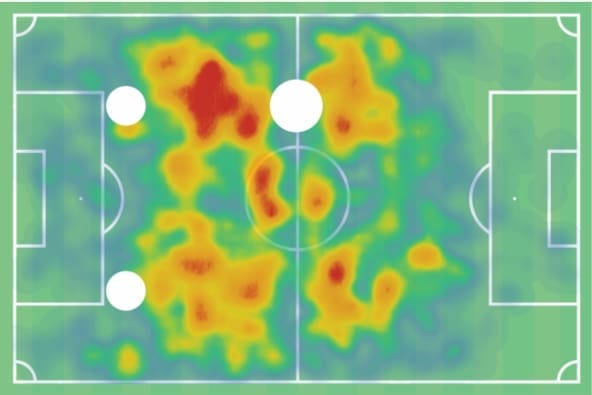
Though originally a defensive/central midfielder, Doucouré has been given the experience of playing as a centre-back this season, slotting in often as a left centre-back while occasionally being deployed on the right side of the back-three as well. However, he’s still most often played as a defensive/central midfielder, mainly being played on the left side though occasionally also on the right side.
Though he plays in a deeper position as a centre-back, Doucouré’s role as a defensive/central midfielder and as a centre-back is still rather similar on the surface. This is mainly due to his high amount of involvement in the build-up including progressing the ball through passes or carries as well as pressing, challenging, recovering, and winning the ball in the defensive phase and in defensive transitions. It’s also not uncommon to see him move further forward as a centre-back and get involved in an advanced area.
As a defensive/central midfielder, Doucouré is very active on both ends of the pitch as you can see in the heatmap above. His playing style fits the stereotype of a box-to-box midfielder. Doucouré mainly stays around the middle third but in defence, he’s willing to drop deeper and defend near or even inside the penalty area if necessary. Meanwhile, in attack, he’ll push forward not only to support the attack and help circulate the ball but also to add to the numbers and potentially help the team counter-press when they lose possession.
Lens is the most aggressive pressing team in Ligue 2. They have the lowest average PPDA of 8.09 this season. This is mainly due to their compact high defensive block. If an opposing team try to play from the back, Lens’ first line of press will quickly engage the backline with one player pressing the ball carrier and the other limiting the ball carrier’s options both by marking them man for man and cutting off the passing lanes with cover shadow.
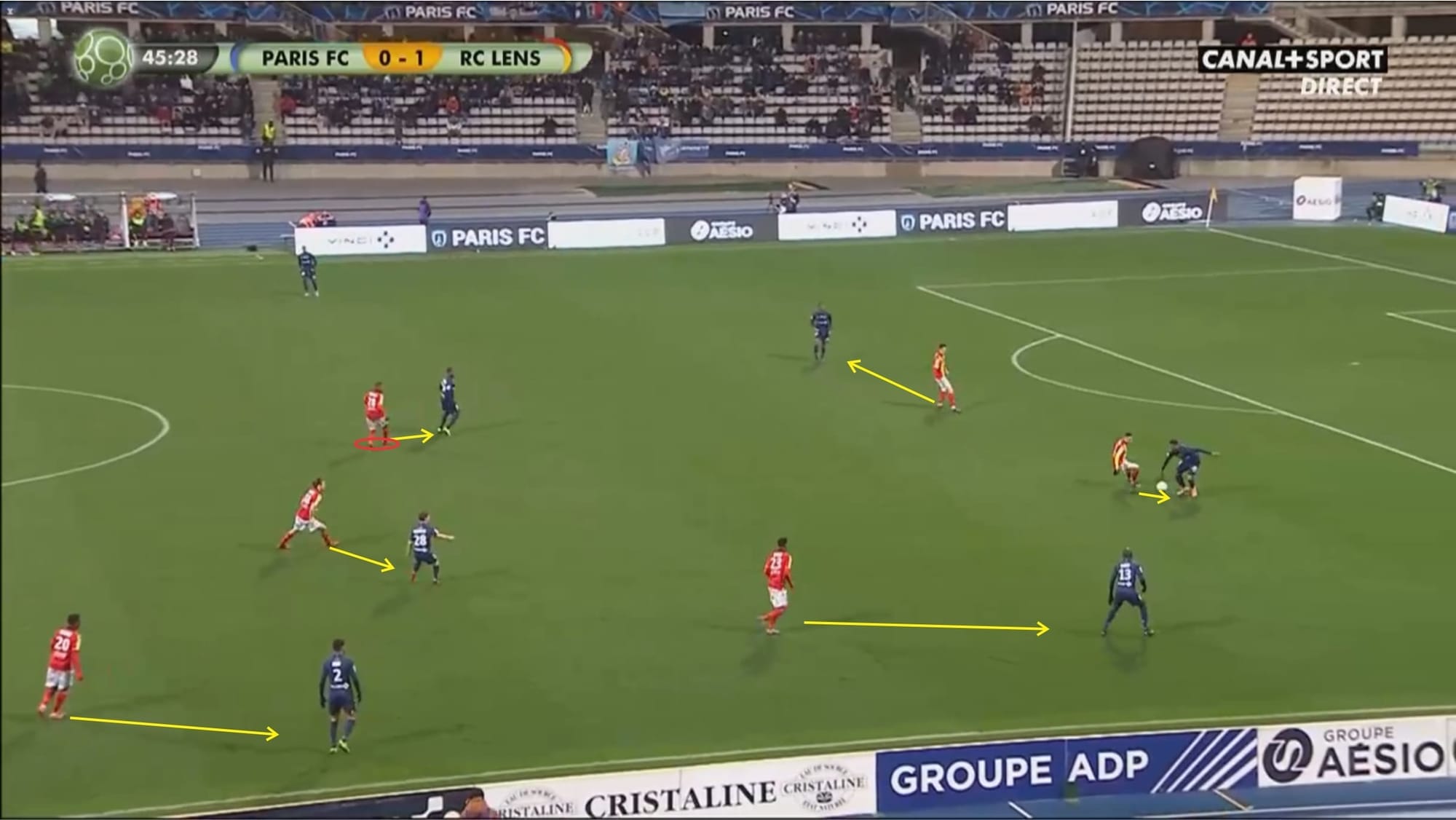
As you can see in the image above, the two defensive midfielders (Doucouré and Yannick Cahuzac) both pushed forward and marked their respective man tightly while the others also did the same to nearby opponents. The presser would actively and aggressively engage the ball carrier rather than just shadowing him, forcing him to rush his decisions. This would lead to a very uncomfortable situation for the ball carrier which could potentially result in loss of possession due to a mistake, poor execution/decision, or a successful tackle by the Lens attacker. Most often though, the opposing ball carrier will try to avoid the high press of Lens by quickly lofting the ball forward, knowing that it would be rather difficult to play their way out of pressure. Due to Lens’ compact shape and aggressive nature in pressing, they also have a good chance of dealing with long balls properly and recover the ball as they usually can win second balls quite comfortably as well as sweep up loose balls in behind the defence.
Simply put, Doucouré’s role in defence is mainly to help prevent central progression by man-marking as well as cutting off passing lanes towards key players in central areas. He’s, of course, also needed to press if an opponent in his zone/space receives the ball, immediately restricting space and not allowing his opponent to turn. He doesn’t seem to leave his post often when in defence but occasionally, there are times when he decides to vacate his position to cover his teammate’s space or when he feels like he can press his opponent and unsettle him.
Lens is also highly aggressive and effective when counter-pressing in defensive transitions and the presence of Doucouré on the field regardless of whether he plays as a centre-back or defensive/central midfielder certainly has a major impact in these situations.
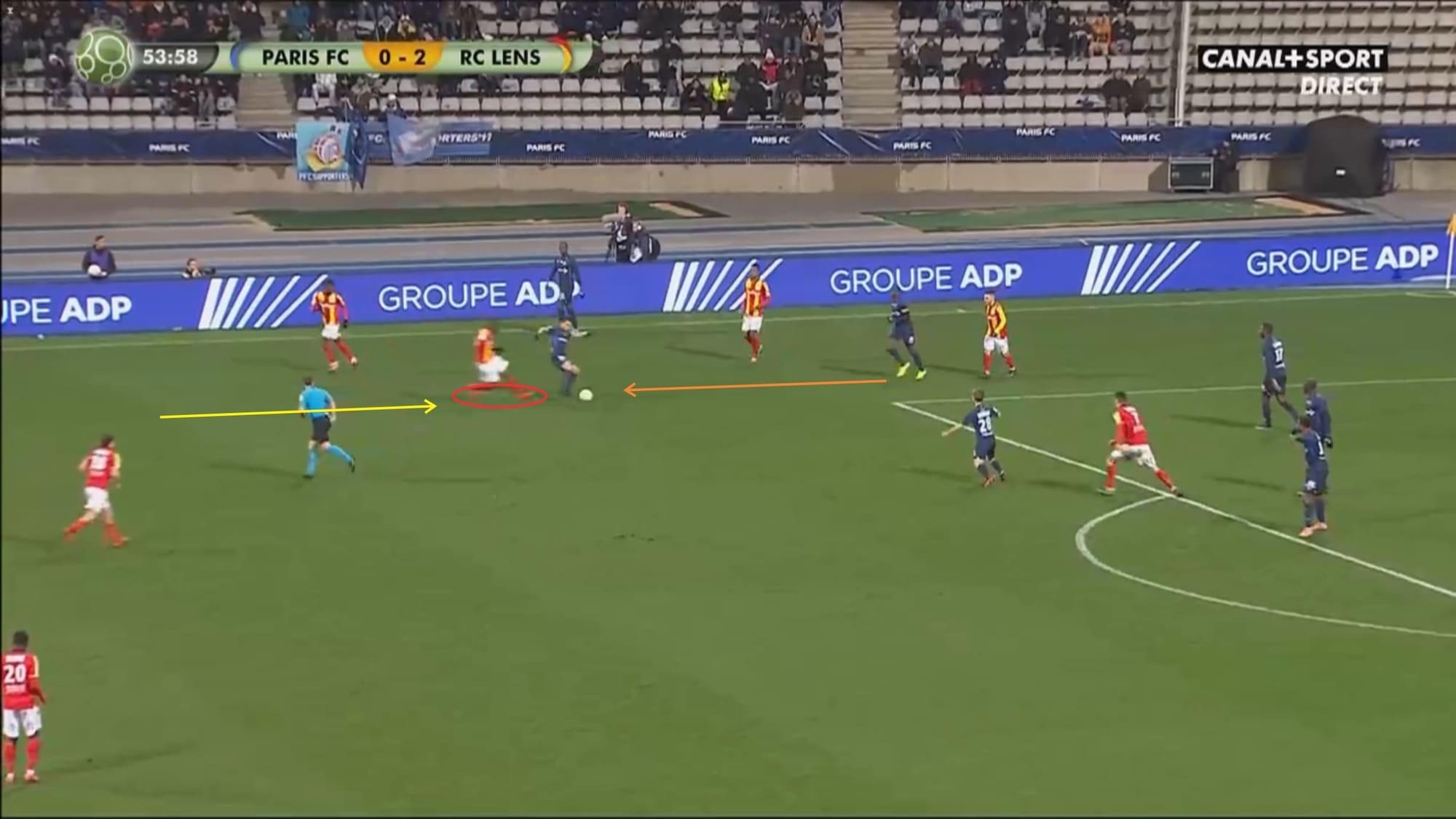
Lens will usually have one or two men pressing the ball carrier whilst others quickly surround the ball carrier and mark the nearest options. This can effectively delay the opposing team’s counter-attack and potentially win the ball high up the pitch. As you can see above, instead of sitting back, Doucouré pushed forward and pressed the ball receiver when the ball was played towards him. This counter-press eventually resulted in Lens winning the ball inside the opposing half.
In attack, Lens usually will play from the back and play their way out of pressure if possible but they seem quite direct and vertical-oriented in their approach. The strikers upfront will often make runs in behind the defence and the backline will look to loft the ball into space behind the opposing defence if the midfield is inaccessible, but normally they would look to play through wide areas to progress.
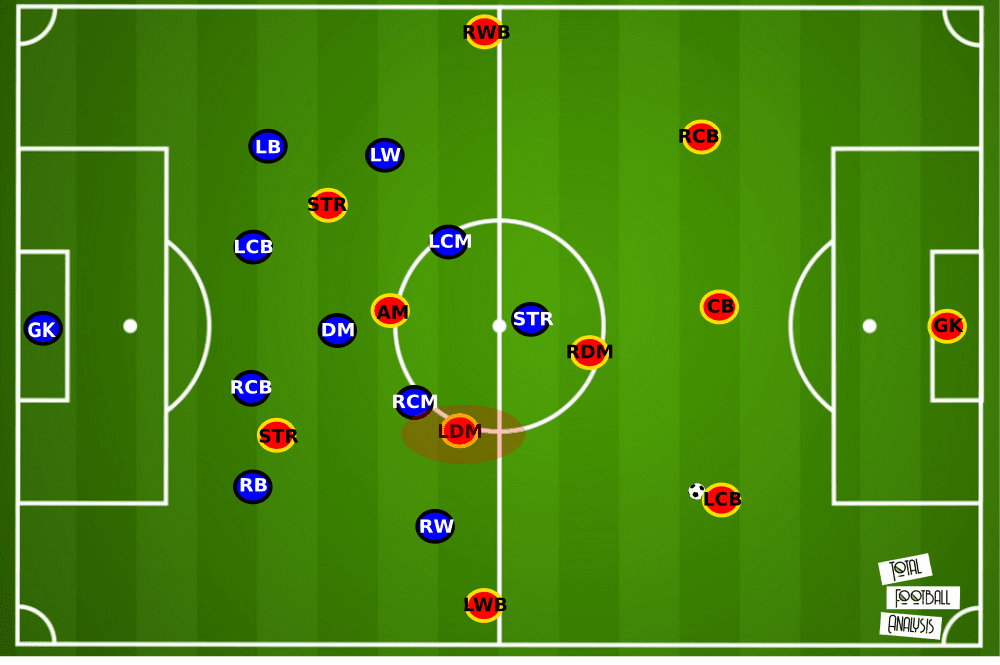
In the image above, Doucouré plays as a left defensive-midfielder in a 3-4-1-2 formation. In the build-up, Lens will look to create a back-three with only one pivot in front of the backline. So, one of the defensive midfielders will stay deep while the other one sits slightly higher. When the team is in possession inside their half, Doucouré usually sits around the middle third, around the centre circle but may drop to offer support if necessary. At times, Doucouré is the one that plays as the pivot while his partner sits slightly higher – the two defensive midfielders may swap roles in a game.
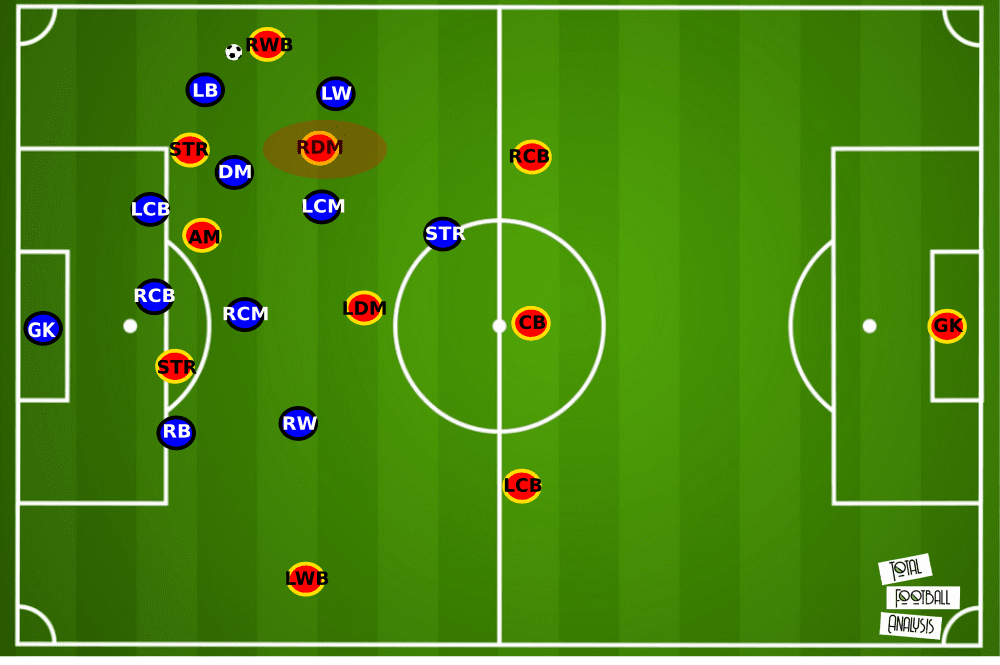
When the team have the ball in an advanced position, the two defensive midfielders will push forward, leaving only three players in rest defence.
In the image above, now Doucouré plays as a right defensive midfielder, still in a 3-4-1-2 formation. As you can see, he’ll also get forward and get involved in advanced areas. If the ball is on the near flank, he’ll move closer and offer support in the half-space. He mainly stays around the middle third and helps circulate the ball rather than making penetrating runs into the box.
Lens is usually pretty straightforward when in possession. They exchange passes with a high tempo and will not hesitate to quickly exploit gaps in the opposing defence. If one area is overloaded then they’ll try to switch play either with a U-pattern passing or with a long pass towards the opposite wing. Either way, the wide player usually gives the ball to the nearest defensive midfielder first when they’re looking to switch play.
Lens is also very direct in their attacking transition. Lens usually has at least two or three players in rest offence. When they regain possession at the back, the players upfront will quickly make runs into space behind the defence, with the wingers often trying to split and stretch the backline by running towards the outside rather than inside. The ball carrier mostly will look to quickly play a direct long ball into space rather than play quick short combinations or drive forward with the ball. Below is an example of Lens in an attacking transition.
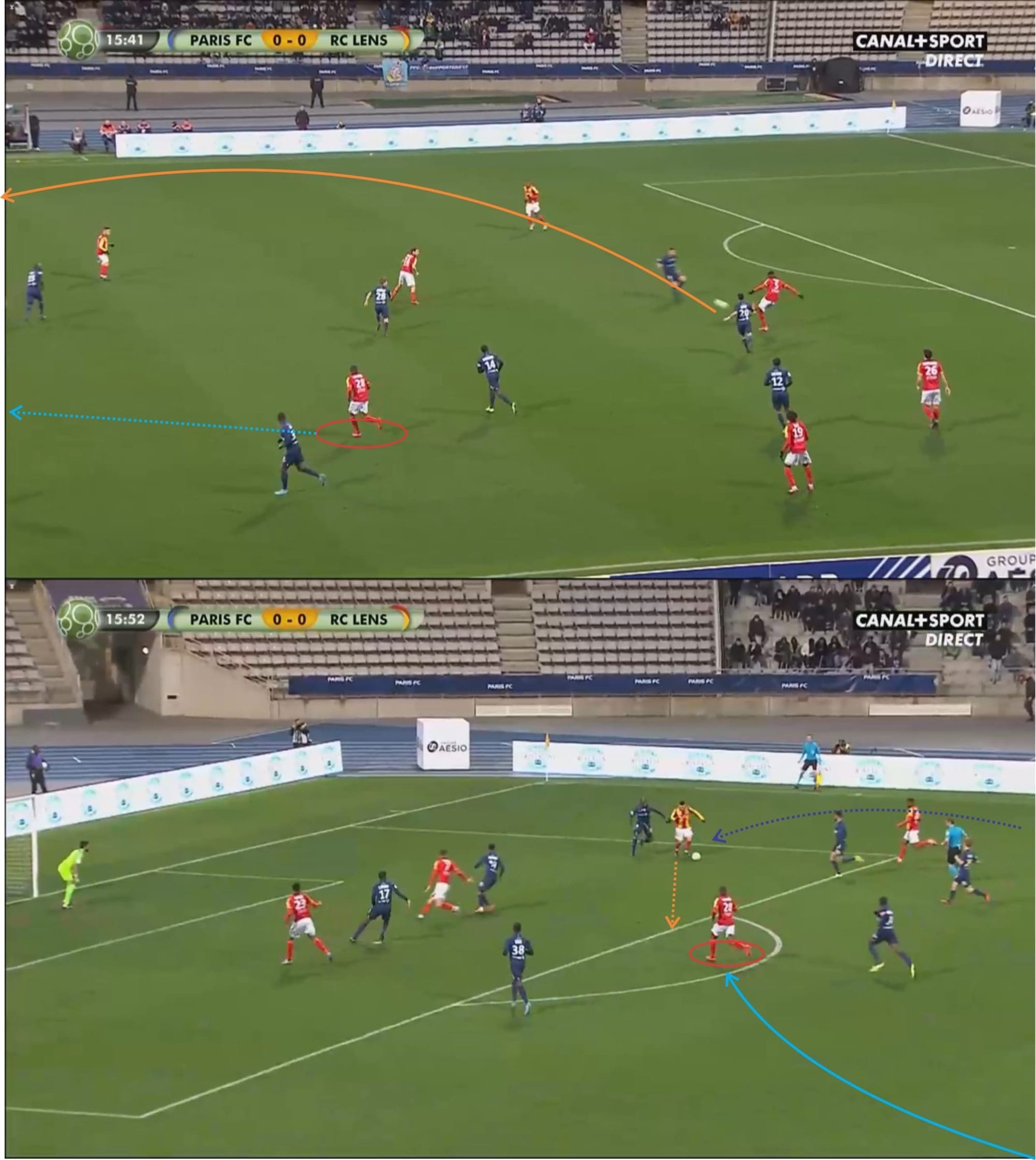
As you can see above, the ball carrier played a long ball towards Tony Mauricio out wide. In the first image, you can also see where Doucouré initially was and then in the second image, 11 seconds after the pass he can be seen arriving at the edge of the box, ready to receive the pass and attack the ball. However, Mauricio, who dribbled forward and drove into the box after receiving the pass had his eyes fixated on the ball and he didn’t see Doucouré there. Instead of passing the ball, the attacking midfielder took a shot instead.
In attacking transitions, Doucouré will also participate by making forward runs although he usually ends up sitting at the edge of the box rather than going inside, making himself available for a cutback cross as well as anticipating potential second ball in the penalty area. Doucouré, however, doesn’t seem to get involved heavily in the construction of counter-attacks, mainly due to the team’s tendency to go direct and get the ball forward as quickly as possible.
Impressive athleticism
Right from the start, it’s very easy to see that Doucouré is impressively athletic and has excellent physical prowess. The 2000-born midfielder stands 1.80 m tall and weighs around 73 kg. He has a medium body build with decently developed upper and lower muscles. Doucouré displays great overall physical ability. He’s strong, agile, quick, and energetic. This impressive athleticism and physical prowess certainly give him a lot of advantage in his game both on and off the ball.
Doucouré has good upper body strength. He also uses his body well to protect the ball and will use his arm to keep his opponent away from him when he shields or dribbles the ball. Doucouré also fares well when engaging in physical duels due to his strength although, of course, players with a bigger build and stronger upper muscles may give him a lot of trouble. He’s certainly not impossible to knock off the ball or beat in physical duels, but opposing players seem to often have a hard time going against him and jostling with him for the ball requires extra effort from them.
Doucouré also seems to have a strong core and a low centre of gravity, allowing him great mobility and balance. This makes him even more difficult to knock off the ball when in possession as even when challenged, he can still stay on his feet and glide past his opponent. Of course, he’s also able to manoeuvre well and change directions very quickly both on and off the ball. He shows no sign of struggling to turn over his shoulder and there’s no indication of lack of hip rotation. Furthermore, aside from being able to control his body well, Doucouré can control his speed well too as he’s often seen being able to quickly accelerate and decelerate in succession without any problem.
Doucouré is certainly not the quickest of player but his speed should not be disrespected. His impressive athleticism and powerful legs allow him to burst-accelerate quickly. He seems to be sharp over short-range and he has shown to be able to reach his top speed swiftly. He’s also quite sharp when he’s into his stride as he can be seen covering medium-long distances quickly although he seems to be sharper over short-range rather than a medium-long range.
Earlier in this scout report, we saw Doucouré’s heatmap throughout this season. The Malian midfielder has a very high work rate. He covers a high amount of area on the pitch and produces a lot of activities inside both halves. Throughout the game, he’s very energetic. He actively presses and engages in physical duels. He actively moves up and down and from side to side. His performance also seems quite stable throughout the full 90 minutes although in the latter stages of the game his performance usually seems to drop a bit, although not significantly – and is pretty normal due to fatigue.
Ball control, dribbling, and vision
Aside from his physical prowess, Doucouré is also proficient on the ball and shows good technical ability when receiving, dribbling, and passing the ball. Furthermore, he displays great intelligence and quick thinking on the ball as well as impressive awareness and vision.
The image below shows Doucouré upon receiving the ball.
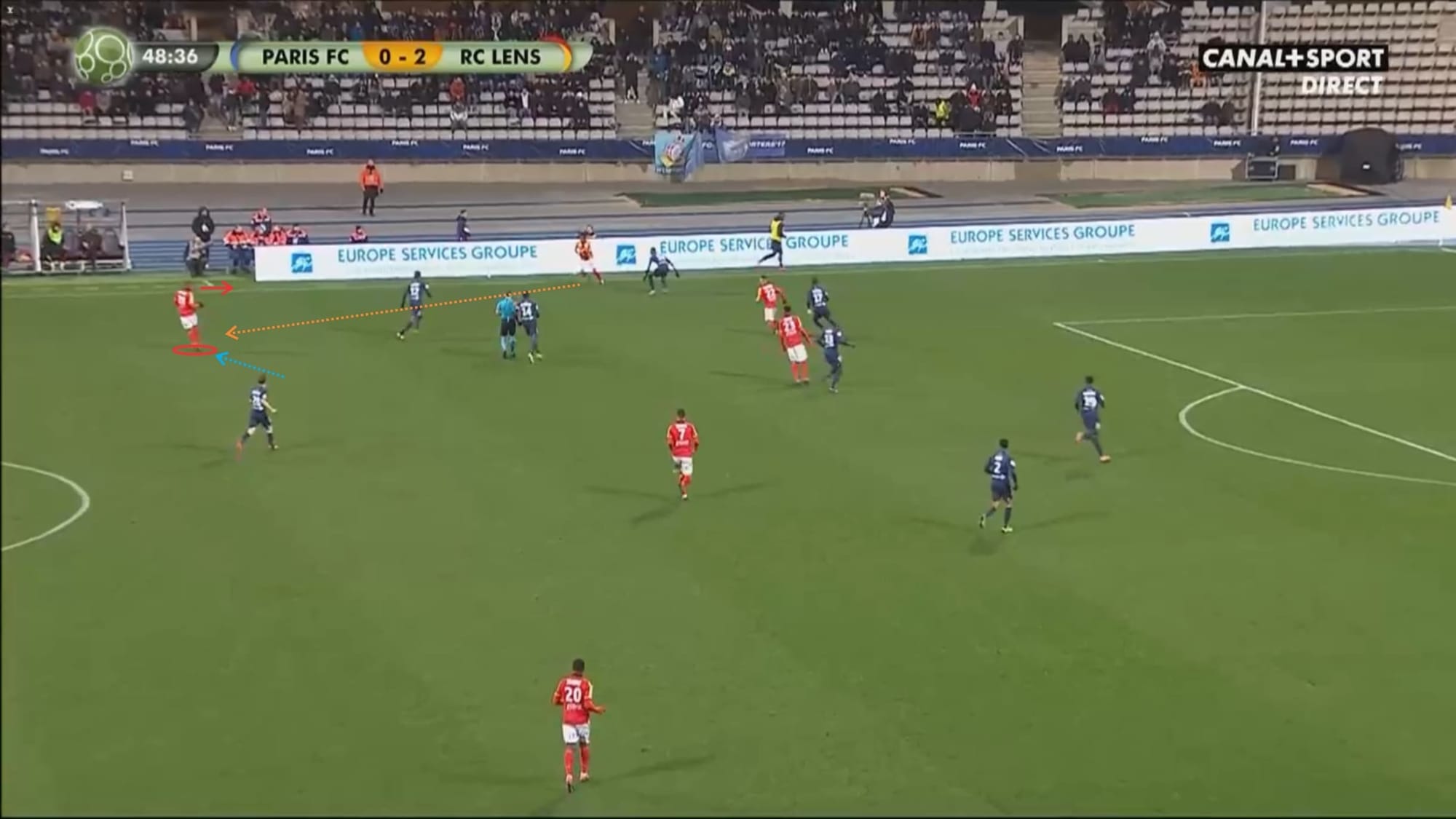
In the image above, Doucouré is noticeably active in scanning and checking his surroundings in pretty much every situation both on and off the ball. In the image above, Doucouré scanned a couple of times and decided to move sideways to break out of his opponent’s cover shadow to make himself available for a pass. He also turned his body a little bit and checked over his shoulder to see potential passing options or space to move into once he receives the ball.
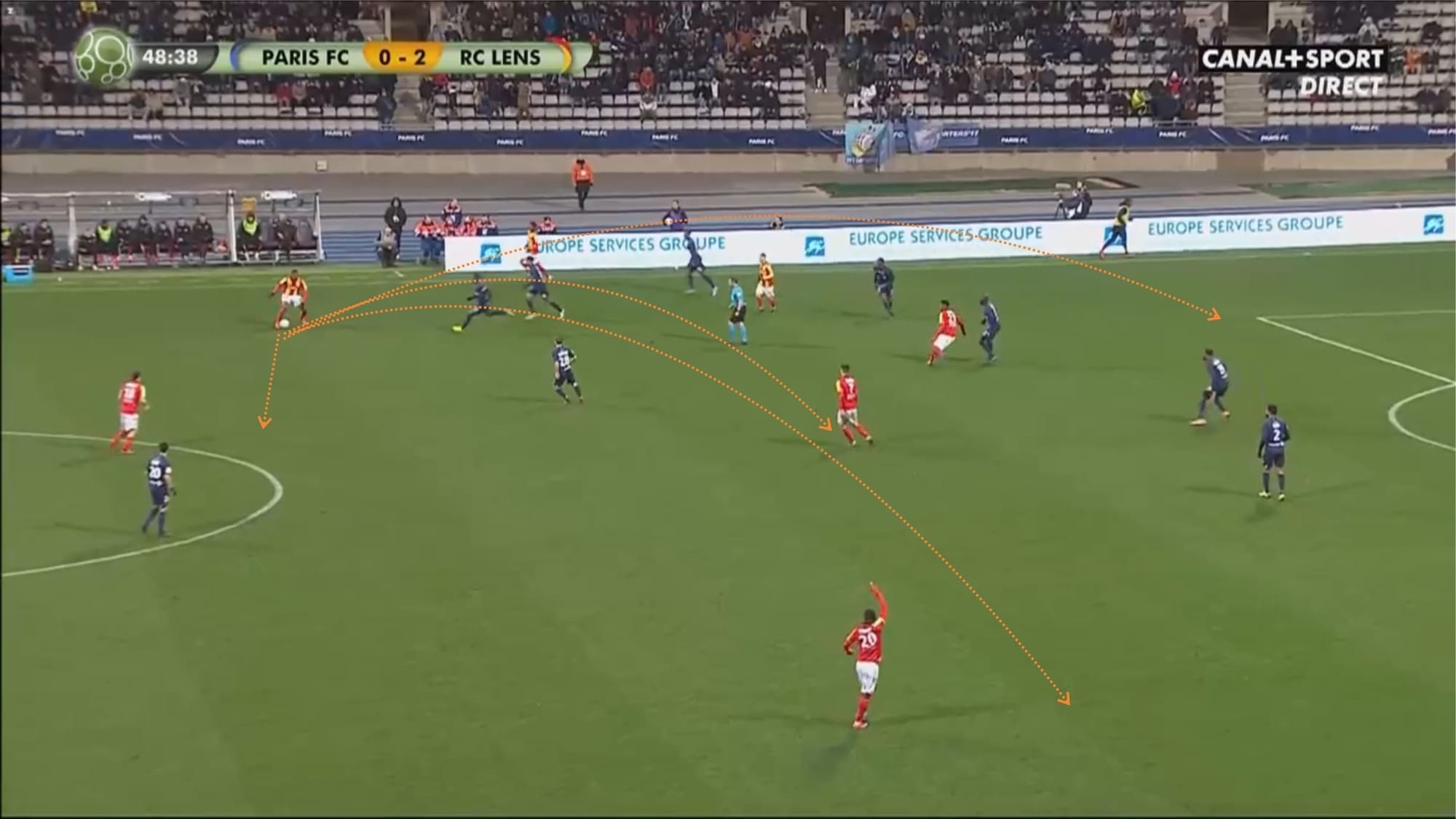
Doucouré mostly also likes to receive with his back foot and allow himself to open his body to get a good view of the field which you can see in the image above. As you also can see above, Doucouré immediately lifted his head and did several quick checks before making his decision and taking his next action rather than focusing his eyes on the ball.

Continuing in regards to his ball control and dribbling, in the two images above, you can see Doucouré driving forward with the ball to exit pressure and open up passing lanes.
Doucouré predominantly controls the ball and leads his dribbles with his right although when forced he’s not afraid to use his left as well. He’s always relaxed and always seems very comfortable on the ball. His touch is usually neat and he rarely loses control of the ball when receiving although at times he may knock the ball a tad bit too far when dribbling.
Doucouré is more of a direct dribbler rather than a tricky, technical one. Though the variety of technique he uses is rather limited, he still shows proficiency as well as comfort and confidence on the ball.
He doesn’t dribble or take on opposing players often but he’s certainly quite effective. Doucouré averages 1.64 dribbles per game with a success rate of 63.64% which is acceptable. Doucouré mainly will carry the ball forward if he finds himself isolated and under pressure, as you can see in the two images above. However, normally, he prefers passing the ball and combining quickly with his teammates with just a few touches rather than dwelling on the ball.
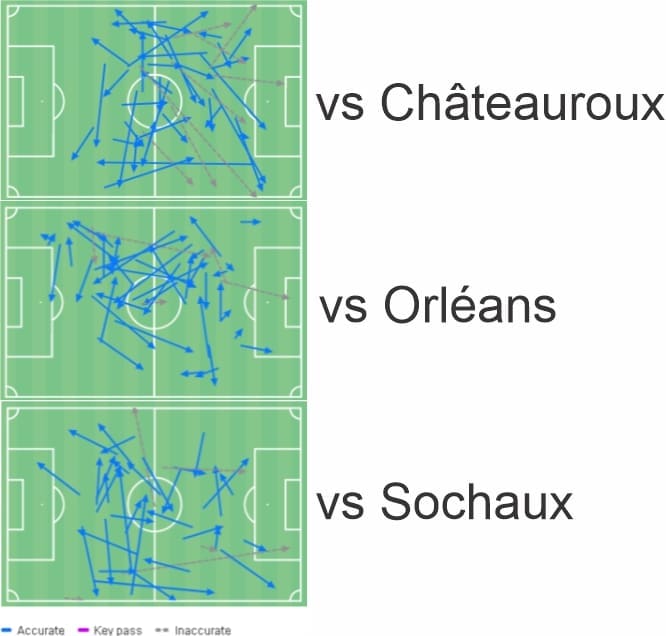
As can be seen, Doucouré also plays a pivotal role when it comes to circulating and progressing the ball. In the pass maps above, you can see his tendency in passing. The direction of his passes may vary but he can be seen attempting a lot of short lateral and forward passes. The length of his passes seems to vary as well. He can be seen playing a few medium and long passes though short passes (0-20 m) are most common.
As mentioned in the previous section in this scout report, helping the team circulate the ball and progress the ball is a big part of his game. Indeed Doucouré averages 9.08 progressive passes per game with a pretty impressive success rate of 82.3%. Doucouré shows great vision in his game. Due to his tendency to scan and his great body positioning, Doucouré usually will have a very good vision of the pitch and awareness of his surroundings and this majorly affects how quickly he makes his decision and the “quality” of that decision. Aside from the awareness and vision, Doucouré displays the confidence and bravery to make the risky, difficult passes. He knows where the space is and where his teammates are and he isn’t afraid to take his chance. With a very good vision and awareness, combined with high confidence in his ability, it is very hard for his opponents to limit his passing options as the Malian midfielder is often able to find a good pass even in difficult conditions.
Aside from that, his ability to disguise his pass also makes it quite hard for his opponent to predict where he’s going to play the ball to. He’d often position himself in such a way to indicate that he’s going to pass the ball towards a certain direction before completely fooling his opponents and passing it the other way.
Perhaps one thing that he could improve when it comes to passing is his tendency to rush his executions. This does not mean that he rushes his decisions though as he clearly shows that he knows what he wants to do and where he wants to play the pass to. It’s just at times he’s a bit too eager to play the ball quickly and decides not to take the time to shape his body up properly before executing which can result to a poorly hit pass. So, usually, the intention is there and the decision is also usually good (picks the best option in that situation) but needs to be a bit calmer before releasing the pass, of course also without delaying too much.
Defensive prowess
Doucouré is solid offensively and defensively. All, of course, linked with his impressive tactical understanding and reading of the game. His intelligent decision making and aggression, as well as determination, also gives him massive advantages in defence. He’s rarely hesitant and is not afraid to get stuck into rough challenges. He may get a bit reckless with his tackles sometimes, but he usually doesn’t go as far as intentionally wanting to hurt his opponent.
The first thing that can be seen is that he’s solid in man-to-man defending. He knows where he should be and how he should position himself. He makes good decisions and press/commit only when he has an opportunity and momentum. Aside from that he’s also not easily rendered off balance by his opponents’ movements and trickery and he’s often quick and agile enough to keep up with his opponents.
Doucouré is highly aggressive and is willing to go hard on his opponents in duels which is very good but at the same time, he’s also calculative and patient. Due to his aggressive nature, he can be quite an intimidating presence on the field.
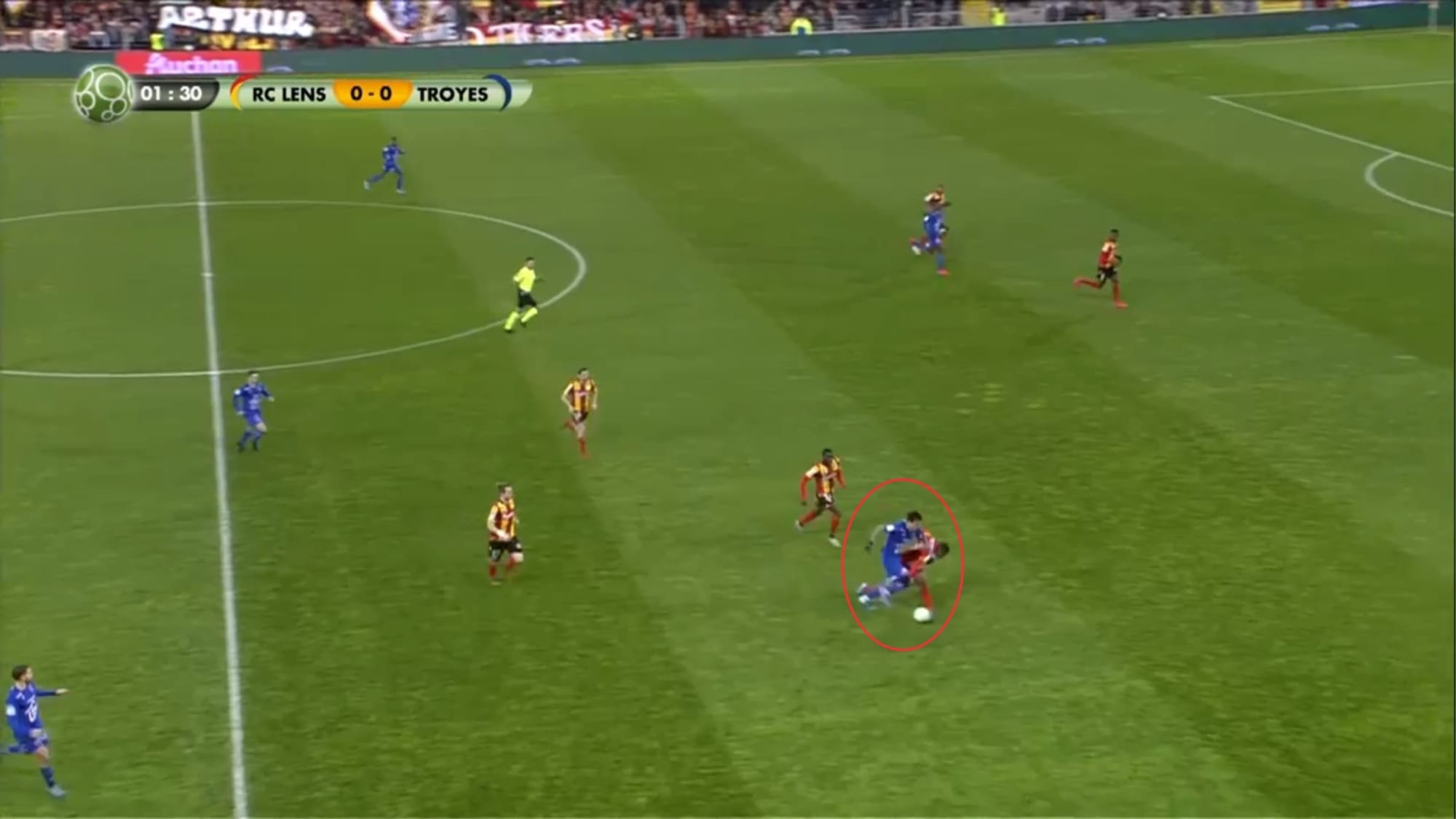
In the image above, you can see Doucouré making a challenge and winning the ball from his opponent. The Malian defensive midfielder kept shadowing his opponent and moved sideways whilst positioning himself between the ball and the goal. He didn’t commit early and waited until his opponent took a big touch before making the challenge and came out winning the ball.
His upper muscle strength also helps him a lot in physical duels as mentioned earlier in this analysis. In defence, he can often knock his opponents off the ball and win it without having to stick out his leg and commit a tackle.
Doucouré averages 7.23 defensive duels per game with a success rate of 60.69% which is quite impressive and shows how effective he can be in defence.
Aside from his impressive ball-winning and man-to-man defending ability, he reads the game very well and always reacts quickly to situations around him. Though his team is not in possession, Doucouré can still be seen occasionally checking his surroundings and he’s always alert and concentrated.
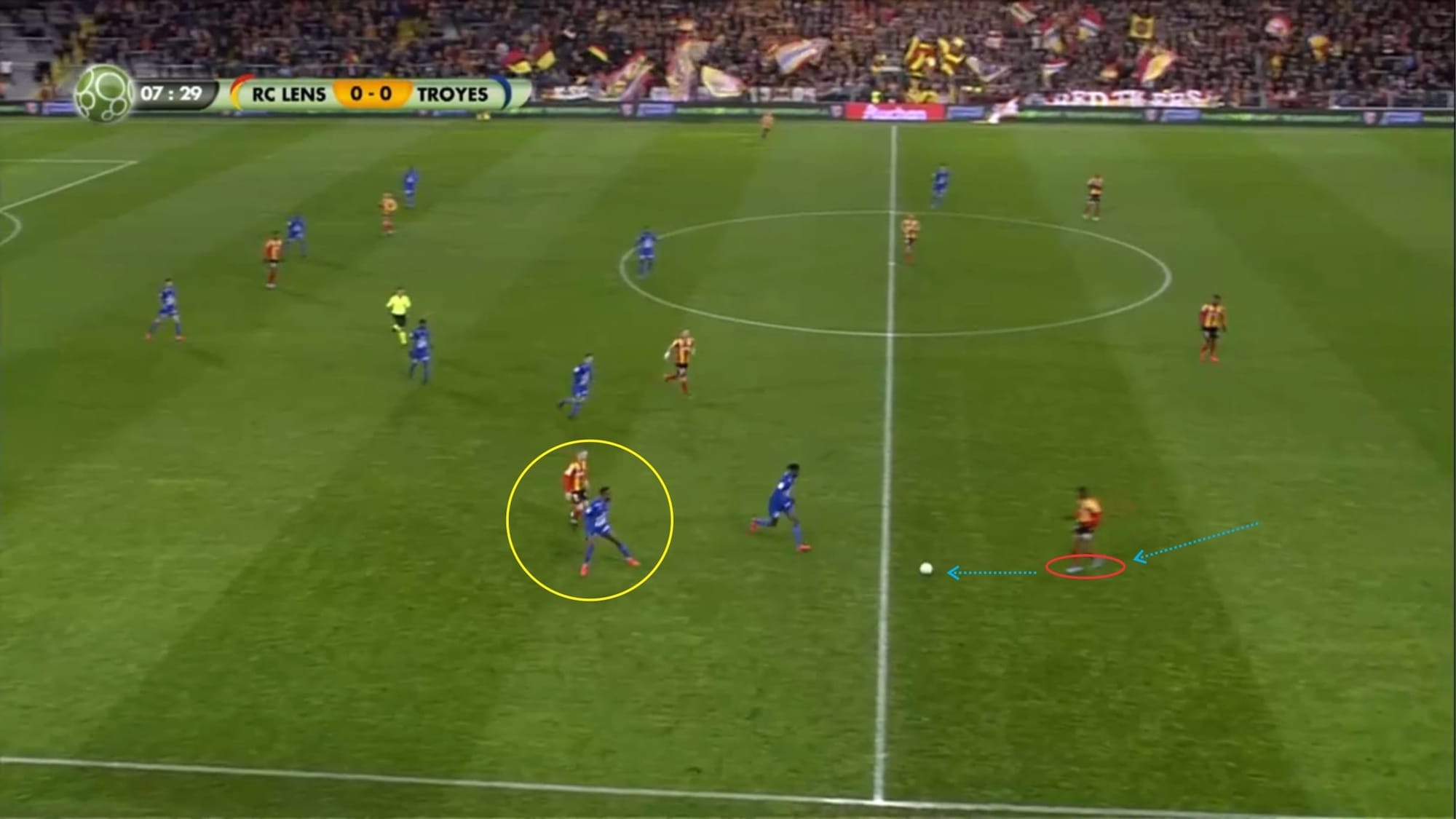
In the situation above, for example, his teammate just lost the ball in the middle third (yellow circle) and the opposing player tried to play the ball into the path of his teammate in front of him. Doucouré already anticipated the pass and reacted quickly. He rushed onto the ball and got onto it first, successfully intercepting his opponent’s pass.
This season, Doucouré averages 4.58 interceptions per game which is a decently high number. The majority of his defensive contributions, however, consist of defensive duels and pressing.
Linking to his role in Lens’ tactics again, Doucouré has shown that his presence is highly crucial in Lens’s aggressive pressing/counter-pressing tactics as he can be seen actively getting involved defensively even in advanced areas.
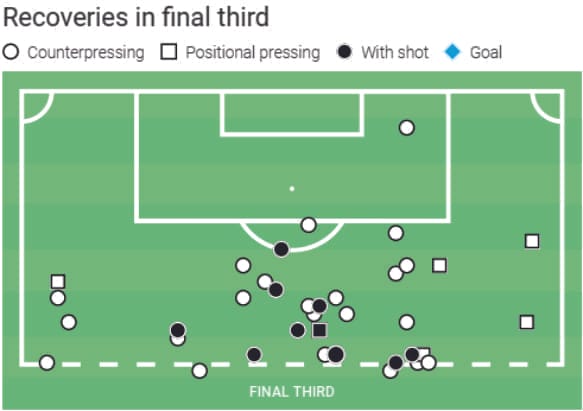
Above you can see Doucouré’s recoveries in the final third throughout this season. The Malian midfielder averages 1.3 recoveries per game in the final third. As you can see, counter-pressing recoveries are very common here and quite a lot of them result in a shot though none have resulted in a goal. Counter-pressing recoveries make up most of his recoveries in a game. Doucouré averages 9.98 recoveries per game and 5.59 of those recoveries come for counter-pressing. This, of course, makes sense due to the team’s high aggression and effectiveness when pressing after losing possession but aside from that Doucouré has shown to be very effective when pressing in a defensive transition.
Conclusion
To conclude this analysis, Doucouré looks like a very bright talent and has shown impressive skills and mentality at his age. It’s quite visible that he lifts his team whenever he plays as he helps dictate the midfield and make the team work effectively and efficiently.
He has a complete skill set and has shown to be a versatile player. He’s gifted with impressive athleticism, he’s very proficient on the ball and technically sound, he’s very intelligent and reads the game well, and he displays high commitment and determination in the game whilst also able to control his temper well. He, of course, has some weaknesses as well – just like every other player. However, with more training and experience, surely he’ll improve his game and strengthen his weak spots.
As for now, there doesn’t seem to be any major interest in Doucouré despite already having two impressive seasons in Ligue 2 with Lens at only 20 years old. The fact that the Northern France side managed to get a promotion to Ligue 1 this season has also helped keep the rumours about him leaving Sang et Or away for now. Doucouré still has a contract until 30 June 2024 and it seems likely that he’ll stay with Lens for one or two more seasons. Still, it will be interesting to follow his development in the future.
Would he be able to follow the footsteps of Real Madrid‘s Raphaël Varane and Borussia Dortmund‘s Thorgan Hazard in the future and play at top-level club? It certainly looks very possible.





Comments